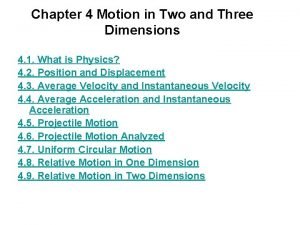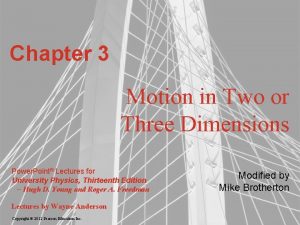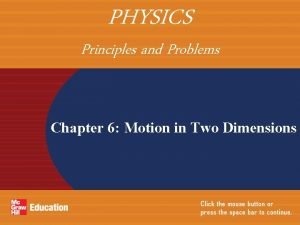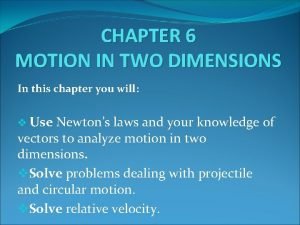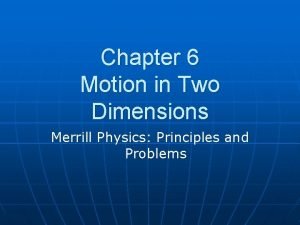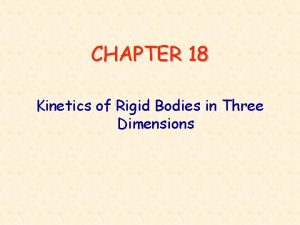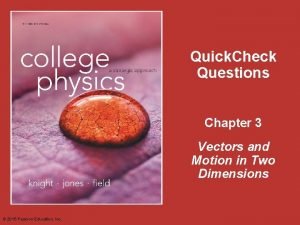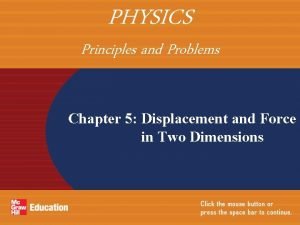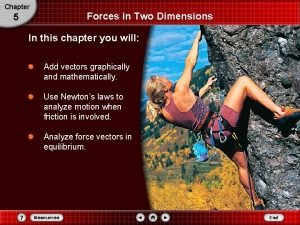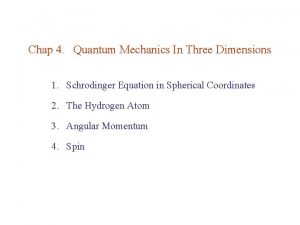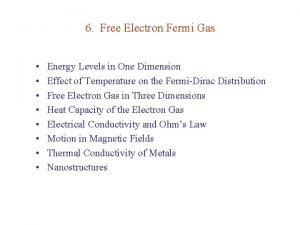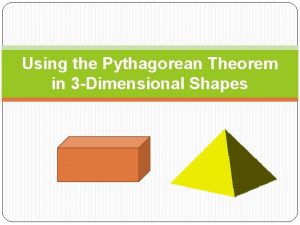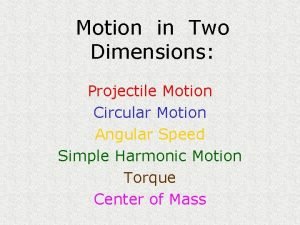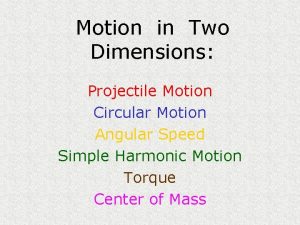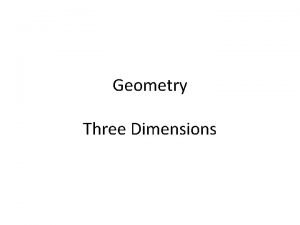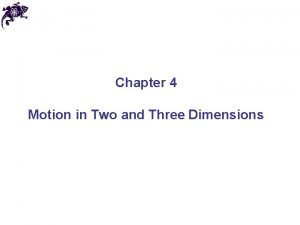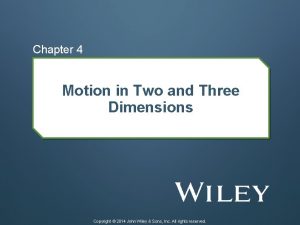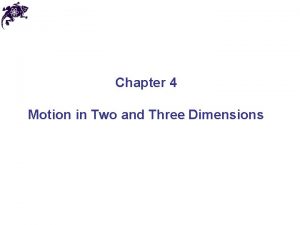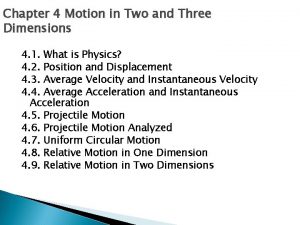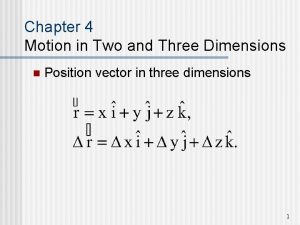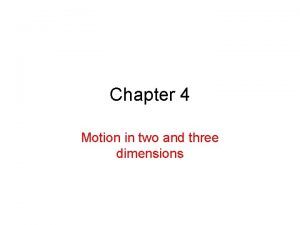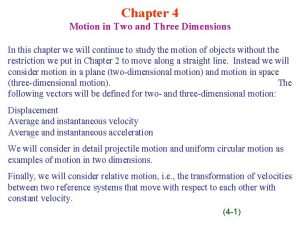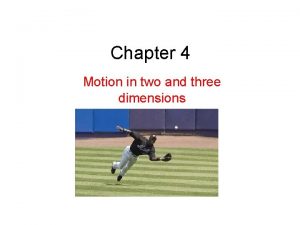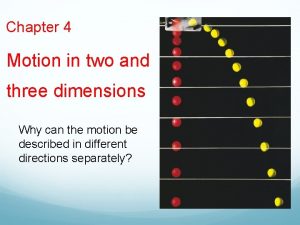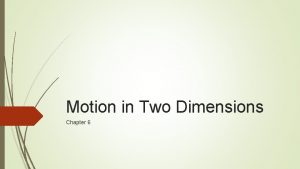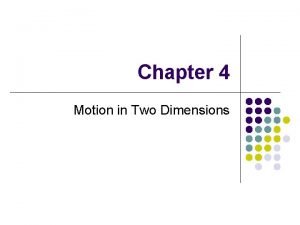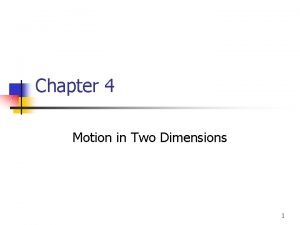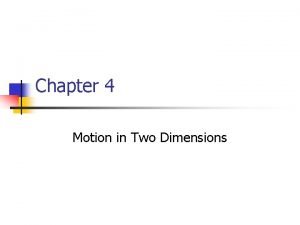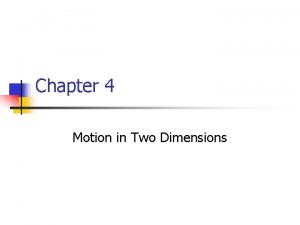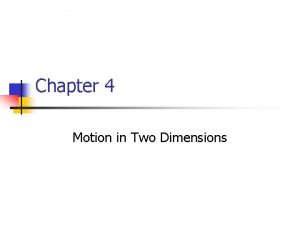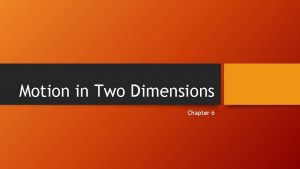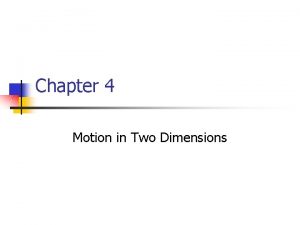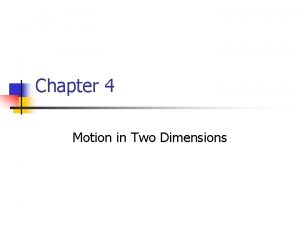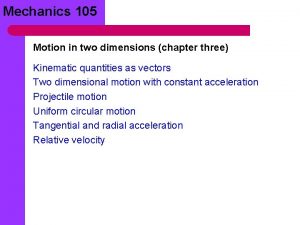Chapter 4 Motion in two and three dimensions


























- Slides: 26

Chapter 4 Motion in two and three dimensions

Two principles for 2 D and 3 D motions: 1) The principle of independence of force 2) The principle of superposition of motion F 1 F 3 F 2

Section 4 -1 Motion in three dimensions with constant acceleration Now we consider a particle move in three dimensions with constant acceleration. We can represent the acceleration as a vector: The particle starts at t=0 with initial position and an initial velocity .

a constant all constants (4 -1) In a similar way: (4 -2)

Section 4 -2 Newton’s laws in three dimensional vector form (4 -3) Which includes the three component equations (4 -4)

Sample problem 1. A crate of mass m=62 kg is sliding without friction with an initial velocity of v 0=6. 4 m/s along the floor. In an attempt to move it in a different direction, Tom pushes opposite to its initial motion with a constant force of a magnitude F 1=81 N, while Jane pushes in a perpendicular direction with a constant force of magnitude F 2=105 N. If they each push for 3. 0 s, in what direction is the crate moving when they stop pushing?

Section 4 -3 Projectile motion Figure 4 -4 shows the initial motion of a projectile at the instant of launch. Its initial velocity is , directed at an angle from the horizontal. We choose suitable coordinate system to make: y mg o x Fig 4 -4 A particle is launched with initial velocity

The components of the initial velocity are (4 -6) Gravity is the only force acting on the particle, so the components of the net force are (4 -7) (4 -8) (4 -9) Position components: (4 -10)

From Eqs. (4 -10), we can eliminate t and obtain the relationship between x and y (after considering Eqs. (4 -6)): (4 -13) which is the equation of a trajectory (轨线) of the projectile, the equation of a parabola. Hence the trajectory of a projectile is parabolic.

Fig 4 -5 trajectory of a projectile y x o R

The “horizontal range R” of the projectile is defined as the distance along the horizontal where the projectile return to the level from which it was launched. Let y=0 in Eq(4 -13), we obtain the range R: (4 -14)


Sample problem 4 -3. In a contest to drop a package on a target, one contestant’s plane is flying at a constant horizontal velocity of 155 km/h at an elevation (海拔) of 225 m toward a point directly above the target. At what angle of sight should the package be released to strike the target?

Section 4 -4 Drag forces and the effects on motions § § § Drag force is a frictional force which experienced by any object that moves through a fluid medium, such as air or water. Drag force must be taken into account in the design of aircraft and seacraft. Drag forces prevent the velocity from increasing without limit in the nature.

Falling motion with drag force We assume that the magnitude of the drag force D depends linearly on the speed: (4 -17) We choose the y axis to be vertical and the positive direction to be downward. and (4 -18) (4 -19) (4 -20)

With at time t=0, we integrate two sides of Eq. (4 -20) then we obtain (4 -21) (4 -22)

• For large t, The magnitude of the terminal speed approaches a constant value, not increasing without limit. • For small t, So (small t) (4 -23) At the beginning of the motion, it is nearly a freely falling motion.

How is D changing with time in general? D D mg mg D mg (for cats) mg It is found that a cat is much safer when it falls from higher place. WHY?

Projectile motion with drag force Y(m) When the drag force is considered, the range R and the maximum height H will be reduced. With drag force Without drag force o R - X (m) The trajectory is also no longer symmetric about the maximum; the descending motion is much steeper than the ascending motion.

4 -5 Uniform Circular Motion In uniform circular motion, the particle moves at constant speed in a circular path. Since the direction of velocity changes in the motion, it is an acceleration motion. How to find acceleration from the constant speed for uniform circular motion? r O Fig 4 -16

Find acceleration for the motion y (4 -25) r O x As the particle moves along the arc from to , it covers a distance of , and a time interval. Acceleration: Fig 4 -16 (4 -27) (4 -28)

In order to find the instantaneous acceleration, we take approaches zero, (then angle goes to zero) so that and both approach p , which gives (4 -29) • Point p is an arbitrary point on the circle, so Eq. (4 -29) is a general result for the motion. • The minus sign indicating that the acceleration at p points toward the center of the circle. • The acceleration is called centripetal acceleration or radial acceleration. The corresponding force is called centripetal force or seeking center force.

4 -6 Relative Motion If we have two inertial frames s and s’, how about the relationship between the motions in them? S’ y’ s P y 0’ 0 s, s’: inertial frame x x’ Fig 4 -17 (4 -31)

Take the derivative with respect to time of Eq. (4 -31), we have (4 -32) Eq. (4 -32) is a law of the transformation of velocities. It is often called the Galilean form of the law of transformation of velocities. It permits us to transform a velocity of one frame of reference (s’) to another frame of reference.

Differentiate Eq. (4 -32), we have (4 -33) The last term of eq. (4 -33) vanishes, because the relative velocity of two reference frames must be a constant. Thus or (4 -34) § The accelerations of P measured by two observers are identical. § Eq. (4 -34) indicates directly Newton’s second law can be equally well applied in any inertial frames.

Sample problem 1. The compass in an airplane indicates that it is headed due east; its air speed indicator reads 215 km/h. A steady wind of 65 km/h is blowing due north. (a) What is the velocity of the plane with respect to the ground? (b) If the pilot wishes to fly due east, what must be the heading? That is, what must the compass read?
 Motion in two and three dimensions
Motion in two and three dimensions Motion in two and three dimensions
Motion in two and three dimensions Chapter 6 assessment physics
Chapter 6 assessment physics Chapter 6 motion in two dimensions
Chapter 6 motion in two dimensions Chapter 6 motion in two dimensions
Chapter 6 motion in two dimensions Chapter 6 motion in two dimensions answer key
Chapter 6 motion in two dimensions answer key Motion of rigid body in three dimensions
Motion of rigid body in three dimensions The diagram shows three points of a motion diagram
The diagram shows three points of a motion diagram Quickchek menu
Quickchek menu Displacement and force in two dimensions
Displacement and force in two dimensions Chapter 5 forces in two dimensions
Chapter 5 forces in two dimensions Chapter 2 section 1 describing motion answer key
Chapter 2 section 1 describing motion answer key What is acceleration
What is acceleration Section 1 describing motion answer key
Section 1 describing motion answer key 4^x = 256
4^x = 256 Range of motion types
Range of motion types 3 dimensions of corporate strategy
3 dimensions of corporate strategy 5 dimensions of diversification
5 dimensions of diversification Quantum mechanics in three dimensions
Quantum mechanics in three dimensions Free electron fermi gas
Free electron fermi gas Three dimensions of justice
Three dimensions of justice The three dimensions of critical thinking are
The three dimensions of critical thinking are Primary and secondary dimensions of diversity
Primary and secondary dimensions of diversity What is diversity
What is diversity 3d pythagorean theorem formula
3d pythagorean theorem formula Three dimensions of corporate strategy
Three dimensions of corporate strategy Three dimensions of corporate strategy
Three dimensions of corporate strategy
